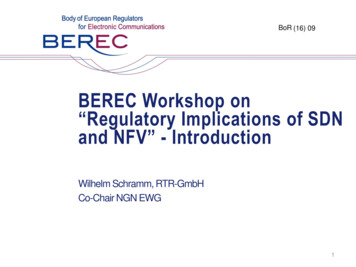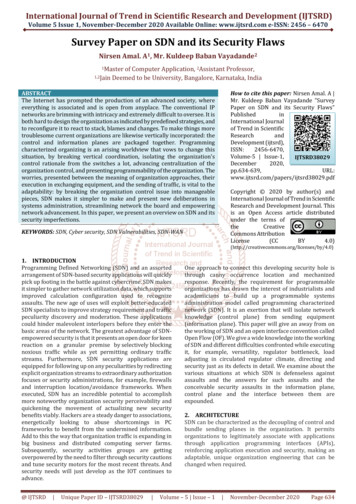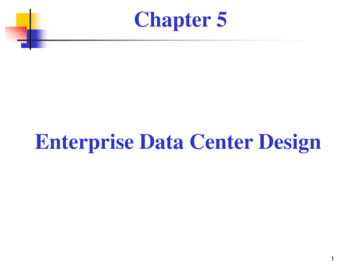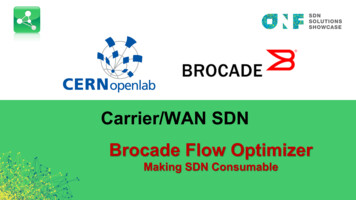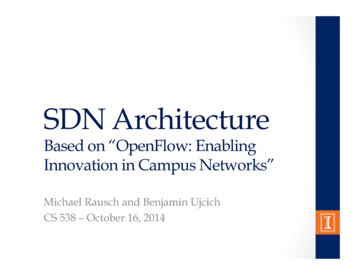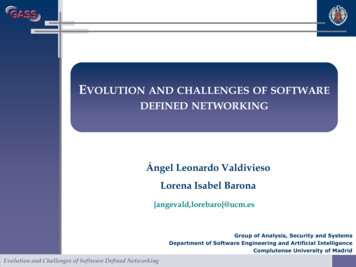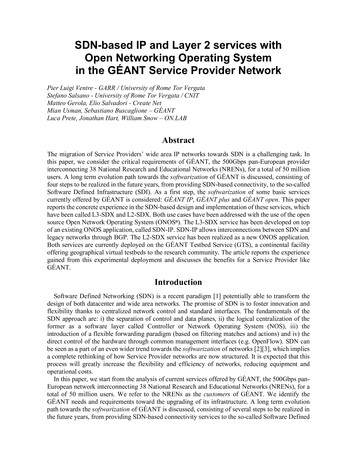
Transcription
SDN-based IP and Layer 2 services withOpen Networking Operating Systemin the GÉANT Service Provider NetworkPier Luigi Ventre - GARR / University of Rome Tor VergataStefano Salsano - University of Rome Tor Vergata / CNITMatteo Gerola, Elio Salvadori - Create NetMian Usman, Sebastiano Buscaglione – GÉANTLuca Prete, Jonathan Hart, William Snow – ON.LABAbstractThe migration of Service Providers’ wide area IP networks towards SDN is a challenging task. Inthis paper, we consider the critical requirements of GÉANT, the 500Gbps pan-European providerinterconnecting 38 National Research and Educational Networks (NRENs), for a total of 50 millionusers. A long term evolution path towards the softwarization of GÉANT is discussed, consisting offour steps to be realized in the future years, from providing SDN-based connectivity, to the so-calledSoftware Defined Infrastructure (SDI). As a first step, the softwarization of some basic servicescurrently offered by GÉANT is considered: GÉANT IP, GÉANT plus and GÉANT open. This paperreports the concrete experience in the SDN-based design and implementation of these services, whichhave been called L3-SDX and L2-SDX. Both use cases have been addressed with the use of the opensource Open Network Operating System (ONOS ). The L3-SDX service has been developed on topof an existing ONOS application, called SDN-IP. SDN-IP allows interconnections between SDN andlegacy networks through BGP. The L2-SDX service has been realized as a new ONOS application.Both services are currently deployed on the GÉANT Testbed Service (GTS), a continental facilityoffering geographical virtual testbeds to the research community. The article reports the experiencegained from this experimental deployment and discusses the benefits for a Service Provider likeGÉANT.IntroductionSoftware Defined Networking (SDN) is a recent paradigm [1] potentially able to transform thedesign of both datacenter and wide area networks. The promise of SDN is to foster innovation andflexibility thanks to centralized network control and standard interfaces. The fundamentals of theSDN approach are: i) the separation of control and data planes, ii) the logical centralization of theformer as a software layer called Controller or Network Operating System (NOS), iii) theintroduction of a flexible forwarding paradigm (based on filtering matches and actions) and iv) thedirect control of the hardware through common management interfaces (e.g. OpenFlow). SDN canbe seen as a part of an even wider trend towards the softwarization of networks [2][3], which impliesa complete rethinking of how Service Provider networks are now structured. It is expected that thisprocess will greatly increase the flexibility and efficiency of networks, reducing equipment andoperational costs.In this paper, we start from the analysis of current services offered by GÉANT, the 500Gbps panEuropean network interconnecting 38 National Research and Educational Networks (NRENs), for atotal of 50 million users. We refer to the NRENs as the customers of GÉANT. We identify theGÉANT needs and requirements toward the upgrading of its infrastructure. A long term evolutionpath towards the softwarization of GÉANT is discussed, consisting of several steps to be realized inthe future years, from providing SDN-based connectivity services to the so-called Software Defined
Infrastructure (SDI) [4][5], which is also able to dynamically offer a wide range of computing /storage / network resources.The first step of the GÉANT migration process consists of the SDNization of some operationalservices. In particular, we consider GÉANT IP, that is the basic service providing Internetconnectivity to the NRENs, and two Layer-2 connectivity services called GÉANT plus and GÉANTopen. These services are currently delivered through 26 Point of Presences (PoPs) located in Europeand 2 Open eXchange Points (OXP) in London and Paris (see next section for further details). TheOXPs are similar to the standard Internet eXchange Points (IXPs), allowing NRENs to exchangetraffic with external (non-GÉANT) networks. The introduction of SDN technologies in an IXP isreferred to as SDX (Software Defined internet eXchange) [6]. In this paper, we give a wider meaningto the SDX concept, extending its potential applicability not only to the exchange points (IXPs orOXPs) but also to the PoPs. We designed and developed two SDN-based services called L3-SDXand L2-SDX (L3 and L2 stands for Layer 3 and Layer 2). These services represent the fundamentalbuilding blocks of the augmented SDX mentioned above and have been developed using ONOS [7],a promising open source solution for SDN control plane.GÉANT network and servicesAs one of the largest and most complex Research and Education Networks in the world, GÉANTneeds to support different services, such as standard IP transit connectivity or ultra-high capacity datacenter interconnections. The GÉANT infrastructure offers extensive links to networks in other worldregions. External peers (other NRENs and external Autonomous Systems) are interconnected through26 POPs, located all over Europe, and two Open eXchange Points (OXPs) (Figure 1). GÉANT offersa wide range of connectivity and network management services as described in [8]. We focus on asubset of them, called GÉANT IP, GÉANT plus and GÉANT Open.GÉANT IP provides IP transit services to interconnect participating NRENs together and withother approved research organization and providers. It provides a peering service for IP traffic,isolated from general-use Internet access. GÉANT plus offers the NRENs point-to-point Layer 2(Ethernet) circuits among end points at GEANT PoPs [8]. The PoPs constitute the backbone of thedual (optical transmission and packet) layer network through which GÉANT supplies connectivityto its customers. From the GÉANT perspective, the PoPs are the end-points of GÉANT IP andGÉANT plus. Finally, with the GÉANT Open service, NRENs can connect with external (nonGÉANT) networks through the OXPs. Inside an OXP, the customers (NRENs or external participants)request the establishment of Layer 2 circuits between end-points, which are manually provisionedthrough VLAN tunnels. The customers can use the Layer 2 circuits for whatever reason, includingprivate BGP peering. Therefore, OXPs are different from traditional IXPs, which provide a switchedlayer 2 infrastructure used by multiple participants to exchange traffic through public BGP peering.2
Figure 1 - GÉANT IP topology and GÉANT OXPsToward a new service development and provisioning approachThe current connectivity and network management services of GÉANT are mostly based ontraditional control plane architectures (IP/MPLS) running on top of complex and expensive,proprietary equipment. In most case, the services rely on proprietary software and specific vendorsolutions making it hard to innovate and offer new services. The management of large-scale networklike GÉANT is largely based on proprietary (and expensive) tools, which, again, constitute a barrierto the innovation. A second issue is that the service provisioning phase often includes manualoperations resulting in provisioning times in the order of days. In such scenario, the introduction ofSDN and in general of the softwarization can bring substantial benefits: i) provisioning procedurescan be drastically simplified; ii) cheaper hardware could replace current equipment; iii) the opennessof the SDN approach avoids the need for complex distributed control plane architectures and reducesthe number of running protocols; iv) proprietary implementations can also be avoided or reduced,mitigating interoperability problems and migration issues. The softwarization facilitates thedevelopment and the introduction of new services of strong interest by GÉANT but difficult toimplement using the current technologies, such as: application specific peering, inbound trafficengineering, load balancing, and steering of traffic for service function chaining [9].3
GÉANT Softwarization pathThe migration of GÉANT network and its services towards a Software Defined Infrastructure is achallenging task, which cannot happen overnight. We decomposed the transition of GÉANT to theSDN paradigm in incremental steps as shown in Figure 2. Each step enhances GÉANT infrastructuremaking it more sustainable, manageable, less expensive and introduces new services/functionalitiesto the portfolio. The transition path also takes into account the operational requirements of aproduction network. This migration strategy rationalizes and extends some ideas already presentedby Monga in [5]. The idea behind the strategy is to initially introduce the concept of SDX, replacingthe current architecture based on PoPs and OXPs, and then to progressively enhance its functionality.The first step of the path is the realization of the L3–SDX and L2–SDX, referred to as pureconnectivity SDX [5][10]. L3-SDX supports GÉANT IP, while L2-SDX represents the SDNizationof GÉANT plus and GÉANT Open. With this first step, there is no full migration to SDN technology,because NRENs can run legacy technologies without direct interaction with the GÉANT SDXoperations.Figure 2 - Softwarization pathAssuming that the NRENs will setup their own SDN infrastructure, the next step, called SDN–SDX consists in the interconnection and harmonization of the SDN infrastructures between GÉANTand the NRENs. To understand the advantages of this step, consider that the NRENs have theircustomers (research organizations) which requires connectivity toward other research organizationin the same NRENs, or in remote NRENs or outside the GÉANT’s NRENs. Thanks to the SDN–SDX, the NRENs and the research organizations could fully exploit the advantages of SDN paradigm,leveraging end-to-end SDN based services spanning the GÉANT backbone and the NRENs.The next step, denoted as SDI–SDX refers to a GÉANT SDN infrastructure augmented with cloudresources: a NREN can request not only networking services but also compute and storage resources,outsourcing part of its computations to the SDX cloud.The final step is referred to as G-SDI, for Global SDI. It foresees a wider adoption of the fullsoftwarization (SDN augmented with storage and computing resources) by all NRENs. Followingthis approach, an end-user (research organization) can obtain compute and storage resources fromother NRENs or from GÉANT leveraging the resources offered through a logically global GÉANTSDX. At this step, considering GÉANT’s position in the European scenario, it will be possible toexploit the Buyya vision of a market-oriented cloud computing [11]. GÉANT’s role fits well as a“super party” that manages the market. This evolution of the GÉANT infrastructure encompasses an4
economic model, useful for the auto–sustainability of the GÉANT project and its participants (theNRENs themselves).GÉANT Requirements for SDN-based IP and Layer 2 servicesL3-SDX and L2-SDX have been identified as the first step of the GÉANT softwarization path. Wecarried out a thorough analysis of the requirements on these services from the perspective of theGÉANT service provider, summarized in Table 1. The requirements are classified as Functional,Non-functional (i.e. referring to performance or reliability), or Operational (e.g. related to monitoringor logging).Based on this requirement analysis, we selected ONOS [7] as the controller platform. In particular,the existing SDN-IP ONOS application provided a very good fit with the functional requirement ofL3-SDX, and the ONOS resilience and distribution features provided a good match with theidentified Non-functional requirements.Table 1 - GEANT SDX requirements5
ONOS: SDN Network Operating System for Service ProvidersONOS is an open source SDN control plane platform, meeting Service Provider requirements,released in 2014 as an open source project by ON.Lab. ONOS provides a stable implementation of ascalable, highly available and resilient Network Operating System (NOS).The overall system has been conceived as a distributed system in the form of a cluster, composedof multiple instances, all functionally identical to each other. The architecture (Figure 3) can bestructured in three tiers: a protocol-aware SouthBound (SB) layer, a protocol-agnostic distributedcore layer, and an application layer. Each tier is a collection of pluggable modules/subsystemsrealizing specific functionalities that make up the ONOS platform. An API is exposed at each tier,providing isolation and modularity.Figure 3 - ONOS ArchitectureThe distributed core is responsible for synchronization and coordination between the instances inthe cluster. It builds a global network view based on information learned on the SouthBound API andoffers services to the application layer. In order to achieve scalability and provide resiliency, variousdistribution mechanisms are available through a set of primitives. Each core subsystem uses theseprimitives in different ways according to the consistency requirements of the state it is managing. Ontop of the distributed state, a logically centralized network view is constructed and presented toapplications. In addition, work is partitioned amongst the instances in the cluster. For example, eachinstance is elected to be responsible for managing a subset of the devices in the network, while theother instances are ready to step in if the primary instance fails. In case of data plane failures, builtin mechanisms for traffic rerouting are activated.The SouthBound layer consists of a collection of software modules called ‘providers’, whichinteract with data plane devices using different southbound protocols. Providers gather informationabout network state and pass it to the distributed core, and receive instructions from the core toprogram the devices.On the NorthBound side, ONOS presents abstractions to the applications, including NetworkTopology, Flow Objectives and Intents. Intents provide applications with a network-centricprogramming abstraction that allows developers to program the network through the usage of highlevel policies that capture what needs to be done, rather than how to do it. The Intent frameworkdetermines how to implement an intent based on what other policies are in the system, and abstractslow-level details of this implementation. Intents make network policies configuration easier, speed6
up management procedures and tend to reduce the occurrence of configuration errors. Intents arebacked by a dedicated subsystem that: i) translates Intents into device instructions; ii) coordinatesand ensures the installation of the generated instructions; iii) reacts to network changes and modifiespaths accordingly; iv) permits optimization across intents translations. The Intent framework hasbeen widely used for developing the L3-SDX and L2-SDX applications.ONOS is supported by an active open source community. Different ONOS applications have beendeveloped over the years by ON.Lab and by the community as listed in the documentation of theproject. For example, the SDN–IP application allows SDN islands to seamlessly interconnect withexternal networks using the standard BGP protocol. Among the applications, we mention CORD (Central Office Re-Architected as Datacenter)[12]. It aims to revolutionize the way Service ProviderCentral Offices are built and operated. It brings in the principles of SDN, NFV, cloud technologiesand disaggregation, thereby making the Central Offices more manageable and agile.High level architecture for GÉANT SDXThe proposed SDX architecture is based on SDN enabled networking equipment, controlled by acluster of ONOS controllers. The ISP services, such as L3-SDX and L2-SDX, are designed asNorthBound applications running simultaneously on top of the NOS, offering both Layer 2 and Layer3 connectivity services. Coexistence of different services in the data plane can be enforced throughslicing mechanisms (e.g. VLAN tagging). As for the networking equipment, their integration ispossible through open APIs, like OpenFlow, or by vendor-specific APIs implemented in ONOS inthe form of pluggable drivers. The use of the so-called white box devices is currently underinvestigation and testing in GÉANT as they could replace traditional equipment to achieve relevantcost savings.A SDX can span a single location (e.g. replacing an OXP or PoP) or multiple locations (e.g.federating PoPs in a single logical PoP, or creating a distributed OXP). This issue is further discussedin the section about the practical experience. The L3-SDX has been developed on top of an existingONOS application, called SDN-IP, while L2-SDX has been realized as a new ONOS application.L3-SDX/SDN-IP in GÉANTSDN-enabled networks still need to interoperate with traditional networks on the Internet. TheONOS SDN-IP application interconnects an SDN island with external networks leveraging the BGPprotocol. The solution allows: a) external ASs to exchange routes and transit traffic through an SDNnetwork; b) the SDN network to advertise routes to the external networks; c) a Service Provider toscale its SDN control plane by segmenting an AS into multiple SDN domains, which communicatethrough BGP. Besides the technical advantages, the Service Providers also gain benefits in reducedCAPEX and OPEX, since they can use a single set of devices to manage (possibly L0/L1), Layer 2and Layer 3 connectivity.The high-level architecture of SDN-IP is shown in Figure 4. The SDN network is composed ofdifferent data plane devices controlled by ONOS, which are directly connected to the BGP-speakingborder routers of the external ASs. Finally, one or more internal BGP speakers peer with the externalrouters and act as bridges between the external domains and the SDN-IP application. From the legacynetworks perspective, the SDN domain appears as a standalone AS, as though it was running legacyBGP routers at the edges. Within the SDN network, SDN-IP has two main roles. The first is to installflows for BGP traffic between the external routers and the internal BGP speakers, thus allowing BGPsessions to be established. The second is to translate received routes into ONOS intents, which arecompiled down into flows on the SDN switches. In order to transport the data traffic in the SDNnetwork, ONOS makes use of multi-point to single-point tunnels, avoiding the use of n x n-1 tunnelsto connect the endpoints, thus reducing the flow table entries in the data plane.7
Figure 4 - High-level representation of the SDN-IP architectureSDN-IP provides a feasible migration path towards the softwarization of ISP networks. It can beintegrated with networks that already use BGP both externally and internally. From an operationalpoint of view, SDN-IP guarantees flexibility in the covered use case, as it does not make anyassumptions on the deployment scenario. The application can run on one or multiple ONOSinstances. Moreover, the BGP settings can be changed dynamically with the addition or removal ofpeers. SDN-IP provides HA within the application itself: the service keeps working seamlessly, aslong as there is at least one instance of the SDN-IP application running. In addition, SDN-IP leveragesthe HA mechanisms provided by ONOS for maintaining a consistent forwarding state in the dataplane. SDN-IP provides a scalable solution able to control large-scale of SDN networks by usingBGP-based confederations and ONOS clusters of different sizes.L3-SDX extends SDN-IP adding the support for new deployment scenarios and providing facilitiesto monitor the BGP and transit traffic in the network. L3-SDX improves the flexibility of SDN-IP,making it is possible to deploy multiple peers belonging to the same AS and interconnected throughdifferent connection points controlled by ONOS. The application supports the typical IXP scenariowhere all the BGP routers as well as the Route Server belong to the same subnet [6]. An integrationwith ONOS IPFIX application allows exporting the counters related to the BGP sessions and to theL3 tunnels using the standardized IPFIX protocol. This can be used to realize advanced monitoringtools. L3-SDX and SDN-IP are both available under a liberal open source license.L2-SDX service in GÉANTL2-SDX is an ONOS application that allows the automated provisioning of layer 2 tunnels betweenendpoints, which can be physical Ethernet interfaces or VLANs. The offered layer 2 services belongto the class of IP Virtual Leased Line services (IP VLL) or Virtual Private LAN services (VPLS),which are a fundamental part of the service portfolio offered by large-scale ISPs. At the time ofwriting, only IP VLL has been integrated in the L2-SDX application, but VPLS can be provided witha straightforward extension of the current implementation. From a customer perspective, the L2-SDXappears as a black box that transports his traffic from the source to the destination end-point, as ifthey were in the same Ethernet LAN. Inside the SDX infrastructure, the L2-SDX application providesthe necessary mechanisms for the service provisioning and monitoring. The human operators can8
manage and monitor the application through a CLI and a GUI, which accepts high-level customer’srequests and translates them into ONOS point-to-point intents.The application is fully integrated in ONOS and implemented as callable service. In a next release,its services will be exposed through a REST API, allowing the integration with orchestrationplatforms. Monitoring is achieved through the ONOS IPFIX application. L2-SDX can run over asingle ONOS instance or on a cluster of ONOS instances that share a common state information. Themulti-instance deployment is useful to control large-scale SDXs made up of many SDN devices. L2SDX leverages the high availability mechanisms provided by ONOS in order to maintain a consistentstate both in the control and data planes. Failures in the control plane are managed through theredundancy of the ONOS cluster. Instead, data plane failures are automatically resolved, throughtransparent re-routing mechanisms provided by ONOS.Figure 5 - L2-SDX application and its abstractionsL2-SDX provides users with powerful APIs and abstractions as shown in Figure 5. A virtual SDX(e.g. MID-EU, LON-UK in the figure) contains a number of end-points modeled as edge connectors,which can be interconnected through virtual circuits. Customers manage only the edges of the SDNnetwork controlled by ONOS. The L2-SDX application eases service management and provisioning,e.g. enforcing isolation and avoiding several types of conflicts: i) the resources (ports or VLAN tags)associated with a connector cannot be reused, ii) an edge connector can only be used in a singlecircuit and iii) a connector in a virtual SDX instance cannot be interconnected with a connector inanother virtual SDX. L2-SDX is available under a liberal open source license.9
Proof of Concepts and worldwide experimental deploymentWe realized two Proof of Concepts (PoCs). The first PoC has been deployed in a laboratory atUniversity of Rome Tor Vergata and used mainly for validation and testing. It is based on VirtualMachines (VMs) and Open vSwitch (9 VMs emulate the data plane, a cluster of 3 VMs composesthe ONOS control plane).Figure 6 - Proof of Concept over the GÉANT Testbed ServiceThe second PoC has been realized in the GÉANT Testbed Service (GTS) [8]. The GTS deliversvirtual testbeds powered by several facilities, co-located with GÉANT PoPs, offering different typeof resources like VMs, SDN devices, virtual circuits. Using GTS, we have built a large-scale PoCwith 7 HP OpenFlow switches deployed in 7 PoPs (Figure 6). This data plane is controlled by acluster of 3 ONOS instances located in three of the PoPs. Three VMs, working as BGP peers, andtwo stub networks with perfSONar hosts have been deployed. PerfSONAR is a performancemeasurement and troubleshooting tool for multi-domain scenarios.The SDX PoC on GTS has been integrated in a worldwide demo hosted at the Open NetworkingSummit 2016, where ON.Lab has successfully deployed ONOS and SDN-IP creating a globalnetwork facility entirely based on SDN. The network spans over 5 continents, interconnecting 9RENs and more than 30 universities and research centers10
Deployment experience and benefits for GÉANTOverall the SDX PoC on GTS worked according to our expectation, L2-SDX and L3-SDX passedall the functional tests that we have performed. Status column in Table 1 reports the coverageassessment of the input requirements. The scalability and efficiency of L2-SDX and L3-SDX aretightly related to ONOS performances, and it has been demonstrated in [7] that the platform can meetcarrier grade requirements in specific deployment conditions. L3-SDX and SDN-IP can scale up to15K routes, achieving the current GÉANT requirement of 12K announced routes.The SDX deployed in the GTS represents a single geographically distributed SDX, spanning 7PoPs, with three ONOS instances running in different countries. During the execution of thefunctional tests, we gained feedback (e.g. the mastership election duration) that drove us not to furtherstress the SDX under critical events like controller instance failure or data plane failures. Therefore,we believe that having single-location SDXs, spanning a single OXP or PoP, is a safer approach tostart the migration toward SDN. OXPs are good candidates for early deployment of SDX due to thecomplexity of the services that are offered and that makes the introduction of the SDN-basedapproach attractive. Moreover, with single-location SDXs, the devices can keep their independenceand troubleshooting capabilities. In the current GÉANT network, each PoP is seen as a “hop” by theIP traffic, while in a geographically distributed L3-SDX simple troubleshooting tools like traceroutewould be no longer useful. Incidentally, we observe that there is a gap to be filled withtroubleshooting tools for SDN based networks, because layer 3 tools based on ICMP (ping,traceroute) do not work hop-by-hop in a network of SDN controlled switches.The transition toward geographically distributed SDX could start with federations of nodescontrolled by the same NOS instance. We have made some preliminary work on this issue withICONA [14] an application to interconnect multiple ONOS clusters seamlessly through an “EastWest” interface. Initially, OXPs could be interconnected creating a geographically distributed Layer2 fabric controlled by ONOS. Likewise, geographically close PoPs could be federated in smallclusters.From the point of view of the development costs, it has been possible to release the L2-SDX andL3-SDX in the PoCs with a relatively small effort (in the order of three man months) thanks to thepossibility of relying on the ONOS code base and documentation.Let us now provide a high-level analysis of the benefits achievable by GÉANT with thesoftwarization of the infrastructures, in terms of operational costs like services provisioning andservices management. The deployment of a SDX in place of an OXP will automate most of theconfiguration operations reducing the efforts of the human operators. Currently, in order to set-up aGÉANT OPEN service between two access points (ports or VLANs) inside an OXP, the customerhas to contact the operators who manually configure the connection [8]. These operations (creationof virtual interfaces, VLAN id selection on both endpoints, VLAN id rewriting) are error prone andrequire coordination between the interested parties. Any arising issue requires further manualintervention of the operators. A typical target for the provisioning time of these services is 5 days.Using the L2-SDX, it will last minutes instead [15]. Moreover, most failure cases are automaticallyresolved by L3-SDX/L2-SDX using ONOS built-in mechanisms (e.g, a failure of a controller issolved using redundancy of controller instances, a switch failure is solved by ONOS with recomputation of data plane paths around the faulty switch).As regards GÉANT IP and GÉANT Plus, similar improvements in the services provisioning andmanagement are an affordable objective with single-location SDX. They represent a tangible resultwhen compared to the current procedures (5 days to obtain IP connectivity or to set-up a layer 2circuit).When considering geographically distributed SDXs, having a centralized view of the networkpotentially brings further benefits like a more efficient traffic management, but the challenges for awide area SDN deployment need still to be solved. In particular, a first issue is the impact of thelatency and unreliability of the control plane connections between controllers and remote network11
nodes. A second issue arises when the controller instances are distributed in a geographical way, inorder to reduce the latency towards the controlled nodes. The mechanisms used to achieve aconsistent view across all the distributed controllers works well in local area networks, where thelatency is low and the capacity is high. The performance of these consistency mechanisms canbecome critical in geographically distributed wide area networks; a careful assessment of theseaspects is still needed.Finally, let us consider an NREN that would like to establish a layer 2 connectivity with a thirdparty (not-GÉANT). Different configurations have to be in place in order to have the connectivityoperational: i) layer 2 configuration of the PoP where the NREN is located; ii) layer 2 configurationof the PoP where the target OXP is located; iii) Steering of the NREN flow into a LSP, provided byMPLS/BGP, towards the destination PoP; iv) establishment of layer 2 connectivity inside the OXP.Despite the services being logically similar, the provisioning procedure can require up to 10 days,because they are managed in two completely separated infrastructures, with specific hardware,different policies and configuration mechanism. Moreover, coordination is needed between all theoperators (GÉANT, NREN and the third
ONOS: SDN Network Operating System for Service Providers ONOS is an open source SDN control plane platform, meeting Service Provider requirements, released in 2014 as an open source project by ON.Lab. ONOS provides a stable implementation of a scalable, highly available and resilient Network Operating System (NOS).
